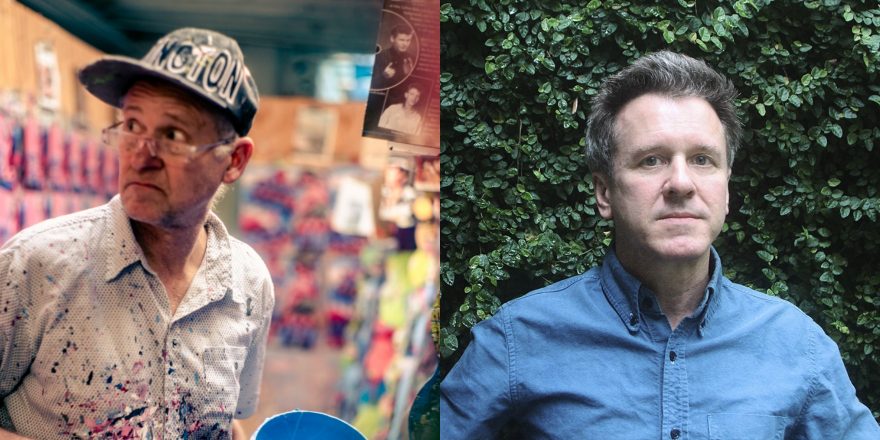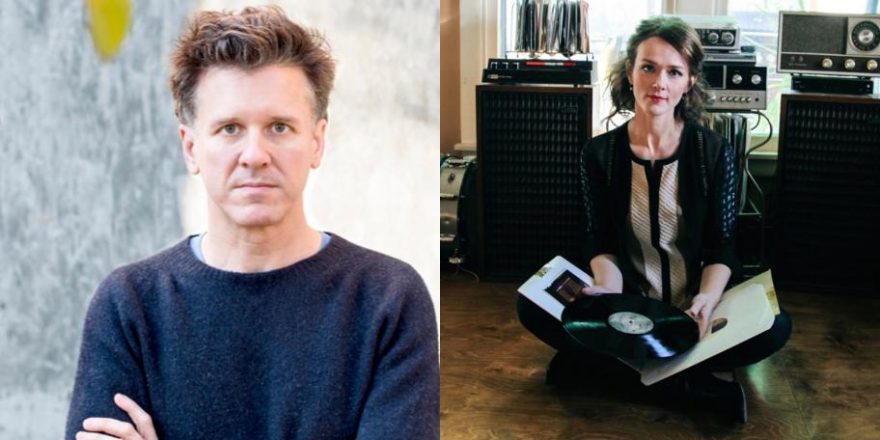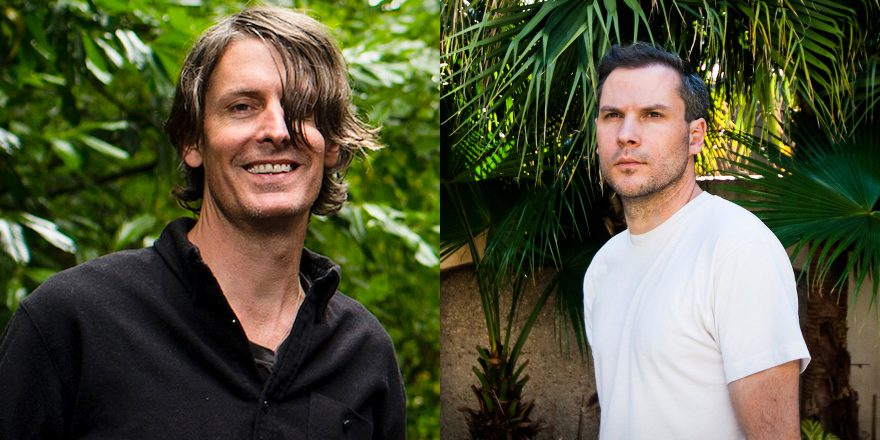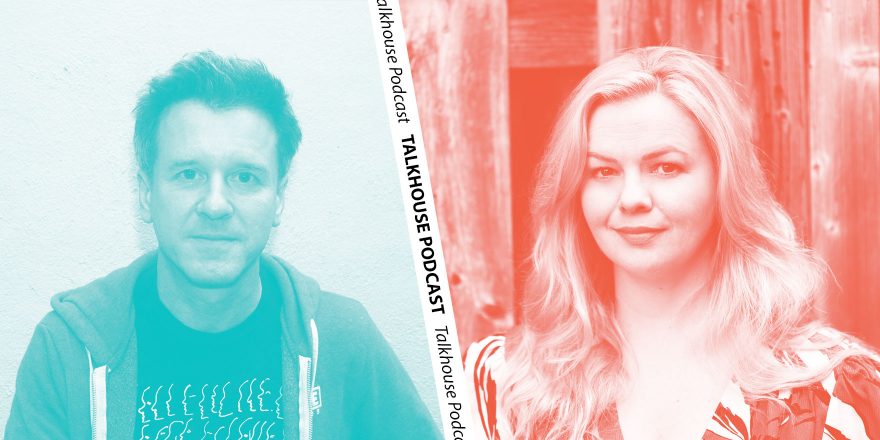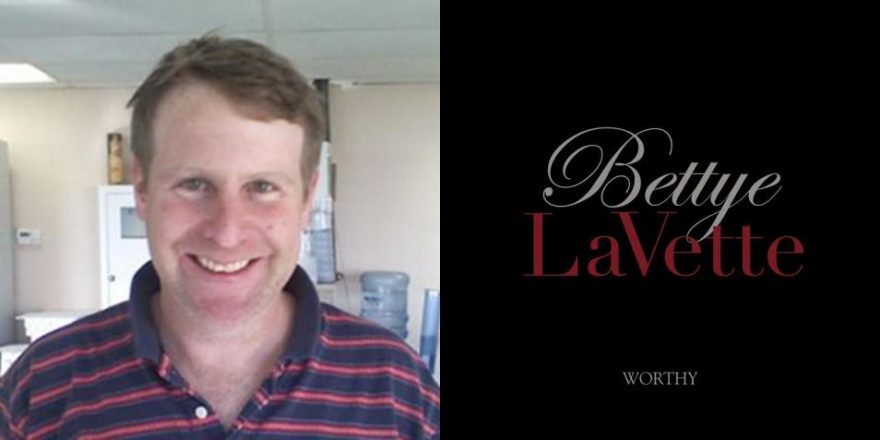Mac McCaughan is a co-founder of Merge Records, and the singer and guitarist for Superchunk. Steve Keene is an artist — the kind whose name you may not know, but whose work (at least if you’re the kind of person who’d read this site) you’ve certainly seen. Keene painted the covers of Pavement’s Wowee Zowee, Silver Jews’ The Arizona Record, and many for The Apples in stereo, including Fun Trick Noisemaker, among others; he’s been called “the most prolific artist of all time” (by Shepard Fairey, a fan), having “mass-produced” more than 300,000 paintings over the span of his 30-plus year career.
Now, a sliver of that work has been cataloged in the The Steve Keene Art Book. Compiled by producer and photographer Daniel Efram, the book also features essays and commentary from fans like Chan Marshall (Cat Power), Will Oldham (Bonnie “Prince” Billy), Ryan McGinness, and more. McCaughan is quoted in the book as well, so to celebrate its release — it’s out today via Hat & Beard Press and Tractor Beam — the two sat down to talk about it over Zoom.
— Annie Fell, Editor-in-chief, Talkhouse Music
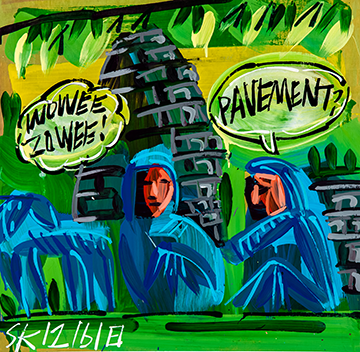
Mac McCaughan: Congratulations on the book.
Steve Keene: Yeah, it’s neat. I didn’t really have anything to do with it. I gave my permission, of course, and I let everybody interview me and photograph me. But it’s sort of like I let them do it. I like it that way, because I’m kind of a control freak. It’s either I have to do it completely myself, or everybody else should do it.
Mac: Yeah. Well, I think it came out great. I love the heftiness of it. It’s a very beautiful book.
Steve: They did a beautiful job to try to evoke — a lot of paintings that I do are just copies of album covers, and so the squareness of the book and the bigness of it, it’s kind of like you’re looking at albums.
Mac: Yeah, that’s true. Not to jump to the end of the process, but I was curious looking at some of the photos, which I assume are fairly recent, of you standing in front of some work that to me is very different than most of the paintings I’ve seen of yours. They’re works that are big, and it seems like they’ve been drawn with — I don’t know what the tool is called, that kind of like burns into the into the wood, and then the paint itself is very thinly applied. Those are amazing looking, and seem like different than I’ve seen before.
Steve: Yeah, that’s my new secret body of work that I’ve been working on for about 12 years. I draw them in Rhino and AutoCAD and they’re cut out by a CNC router. So it’s sort of like I do these drawings and then the machine makes it. I’ve been pretending I was a machine for 30 years.
Mac: [Laughs.] Right.
Steve: So I do this other body of work, and I don’t sell them yet because I kind of want to hold on to them to just kind of make a big event one day, like a Lollapalooza of it or something.
Mac: Those are really cool. And so the router is controlled by a machine? Once you do the drawing, it follows the instruction basically?
Steve: Yeah. It’s just like a machine that would cut wood, make furniture or something like that.
Mac: It’s like you finally have an assistant, but it’s doing exactly what you say.
Steve: Yeah, I’ve had studio assistants over the years, every once in a while, and that’s fun. But — I don’t know, we live in a really big space, I have lot of space to work, but there’s still never enough room.
Mac: Right. I see all the work stacked up behind you, too. So storage, I’m sure, becomes an issue.
Steve: Yeah. I mean, most of my paintings, as soon as I paint them, they’re gone. Because I’ve been doing the website for a long time, and people know about my work — if you’re into it, you’re into it. Right now, I have about a seven month wait list for my website stuff. [Packages of six randomly selected paintings by Steve are available to order on his website, for only $70.]
Mac: Wow.
Steve: But people are nice about it. I’ve just seemed to get a lot of press — too much press, in the past couple of years. It’s been kind of wonderful. It’s what I always wanted, because I always did this stuff. And I like it that people understand how it’s connected to my kind of hero worship of the music industry. Like I’m an artist, but I never really liked the art world. I always thought it was kind of odd and didn’t move fast enough somehow. Or it was all about, you had to be the best or you didn’t exist, right? And the music world is different. It’s sort of like you can be a bunch of friends and go in a band and drive seven hours and play in front of five people and sell four CDs, and you had a great time. And that was so inspiring to me. It’s like, Hey, you don’t have to be the best. You just have to be your thing.
Mac: Right. And I feel like you found a way around what I see as a real difficult part of being an artist that’s in the, quote-unquote, “art world — I see friends work on a body of work, and that body of work may just be ten paintings or something, but [they] work on that for a year or however long it takes. And then [they] have a show, and then those paintings are either sold or they’re not sold. But you can’t have that same show in a year, and so you have to then start all over again. Whereas as a musician, you can’t release the same record twice, but you can play the same song every year for 30 years like we’ve done. You can have a song that people know, maybe, and relate to, and then you can keep playing it every time you come to New York or Nashville or wherever it is. Whereas [with] art — you can’t have a show and be like, “Hey, remember this painting you loved last time? Here it is again.” [Laughs.]
But you found a way to you found a way to make it so that people could have access to [your work] — in other words, your paintings are like records, because there’s more than one copy of our album, you know what I mean? There’s as many as people want. So you figured out a way to kind of do that with art.
Steve: Well, a lot of times I paint the same things over and over again — I always stick stuff in my grab bag from my website, I sell my art sight unseen, people don’t know what they’re going to get. And over the years, I kind of know what people are not going to hate. So I try to include that. I want people to like what I do, I don’t want people to feel ripped off.
But when you’re talking about you guys doing the same songs for 30 years — I mean, it’s old, but it’s always new. It’s new to the people that have seen it for the first time at your show. So you’re doing a performance, you’re doing a reinvention of it right in front of them. You’re making it new. What you’re saying about the regular way to do art, and my kind of pretend art is what gets me excited about it. I could do one picture for the rest of my life — like, hundreds and thousands a year of the same picture — and it would still be new to everybody who gets it. And I like that. And it’s new to me every time I paint it.
Mac: That’s interesting, because there’s definitely been times in our life as a band where we would go for a couple of years without playing a song, just because we got tired of it or whatever. And that was usually a song that people wanted to hear, because that’s why we had played it so much in the first place. And I think sometimes it’s helpful just to remind ourselves — or someone will remind us, “Yeah, you guys might be tired of that, but there’s going to be people at every show that that’s the only time they’re ever going to see you. So do you want to have them leave going, I just wish they would have played my favorite song.” Seeing some of my favorite bands over the years has reminded me of that. Seeing Dinosaur Jr, seeing Mudhoney, seeing David Byrne on Broadway — people that aren’t afraid to play their biggest hits because they know that that’s going to bring people joy.
Steve: I mean, that’s kind of their job. When you’re a musician or if you’re an artist, you want to create for yourself. But you’re grateful that you have an audience, a loyal following, so you need to deliver. And you need to make it fresh for yourself.
Mac: Well, and that leads me to a question: I remember reading an interview with Martin Phillipps from The Chills and him talking about playing a song like “Pink Frost,” a song that he’s played a million times. But he said, “Every time you play it, you can still draw on that same emotion that made you write it in the first place, because it’s still you and that’s still in there somewhere, so the performance is going to be authentic.” And so I was wondering what role emotion plays in your painting.
Steve: I try to make it a craft, so I just sort of have a system. I always get into trouble if I try to think that I need more out of it than just delivering what I’m good at, because what I’m good at sometimes surprises me. But there’s always times where I feel agitated or I feel a certain way, or I’ve looked at other art and think, I need to add a little bit more of this kind of thing. And then I sort of have gone off the road and I have to kind of get back. But my craft, my style, basically —I’m always happy when I look at people selling my old pictures on eBay and they look like what I’m doing now, because I don’t want to change. But it’s kind of impossible for your work not to change. You don’t buy the same paints as you did 30 years ago, you don’t work in the same space, you don’t have the same materials. Things do evolve.
Mac: And you are a different person, in some ways I’m sure, that you can’t help it. In our son’s room, we have a Yankee Stadium painting — he’s a big baseball fan — but if someone said to you today, “Do another one of those Yankee Stadium paintings like it,” there’s no way it could look exactly the same for the reasons that you’re saying.
Steve: Yeah, I would respond differently to the paint. But I try to keep it the same. And that’s why I do this other body of work that’s based on the computer, because doing this for 30 years, you can’t help but suck in more and more stuff, even though you know it’s maybe not helpful. But you suck it in and it inspires you, so you’ve got to find an outlet to use it or you’re going to put too much into your day job.
Mac: Right. Well, I’m curious about the the role that music has played in your art. Obviously, the album covers and everything are right there to see. But when you were a kid, was art always something that you were interested in? Or was music your way into the art world in terms of what you’re interested in? Or were you always interested in paintings as well, as a kid, going to museums and stuff like that?
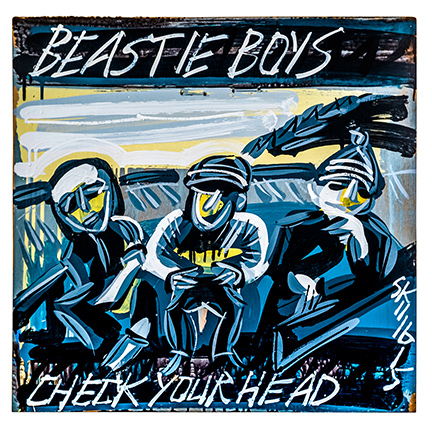
Steve: Yeah, I remember I wanted to be an artist in fifth grade, in 1967. And I was lucky enough the library opened about a few blocks away from us when I was 10 years old — I would go and I would just sit there and look at the art books. I know I was into music around that age. I think the first album I had was Snoopy Vs. The Red Baron, and the first single I had was “Lady Madonna.” But then I don’t remember rock music, I liked classical music.
Mac: Is this all in Charlottesville? Or is this somewhere else?
Steve: No, in Northern Virginia. And then once I started working in a restaurant, everybody’s listening to rock music. So that’s when I started listening to Jethro Tull and the Doobie Brothers and everything, towards the end of high school.
Mac: So that was like the ‘70s. There’s plenty of ‘60s and ‘70s records in your oeuvre.
Steve: I like doing it because for me, painting the albums, they’re kind of like memorials to a time when you’d go to a record store and you had $7. and you would be in the record store for an hour-and-a-half — Am I going to get Derek and the Dominos or am I going to get Live at Fillmore East? It was like this physical thing, and the only way you could tell was looking at it and staring at it.
And then my wife went to architecture school — we moved to Charlottesville, she went to architecture school at UVA, and we were deejaying on WTJU for a few years, just surrounded by what felt like tens of thousands of albums. Whe way we’d make a radio show, you have your core bunch of songs you like, that everybody else kind of likes, but that didn’t make a great show. The great show was finding the weirdest record covers and then queuing up some songs ahead of time and putting them on real fast, and just making a weird show.
It was around ‘88, ‘87, ‘89, and we started being friends with the people at the station, and they were all 10 years younger than us. But we had a radio show where we played all this weird ‘70s kind of music that sounded like proto-grunge, and then you Green River and Mudhoney and stuff, and it fit. So we kind of kind of fell into creating this little sound. We thought it was cool.
Mac: Yeah, that’s a great radio station. College radio was such an important thing in so many people finding out about music. For me, that was how I went from liking the bands I already liked because they were on rock radio in the ‘70s — The Who and AC/DC and Led Zeppelin and all that. And my dad had Rolling Stones records and Led Zeppelin records and stuff like that, so that’s kind of what I grew up listening to. And then we moved to North Carolina and there’s UNC and Duke — both have great radio stations that we could pick up, and it was like a whole other world of music, which you would see occasionally covered in Rolling Stone or whatever I was reading. You know, you would see a review of the R.E.M. record, or maybe something about punk. But just finding out about new bands and local bands — that was the only place that you could ever hear a local band on the radio, would be on the college station.
Steve: Yeah, it was magic. We we stayed in Charlottesville a few more years than we thought we were going to, just because we didn’t want to move away from the radio station. We didn’t want to move away from listening to the radio station. It was crazy. You’d have all this music that was directly piped in from New York City, and then we’d drive 10 miles away from the campus, and we’re living in the country with cows and everything. It was great.
Mac: Yeah, that’s awesome. Well, one thing I was wondering — in my studio, I have a few of your paintings, and a couple are just straight album covers — Freewheeling Bob Dylan and Bruce Springsteen, Born to Run — and then there’s this “Dust in the Wind” painting, which is not an album cover, i’s a lyric. But then it’s a picture of two Empire State Buildings.
Steve: Yeah, I see that. Or it looks kind of like a mormon temple or something, in a way. [Laughs.] Yeah, it’s Empire State Buildings.
Mac: And so I was wondering about that. There’s the album covers and then there’s the history paintings and then there’s landscapes, kind of like the Yankee Stadium one that we have. How do you decide if you’re going to combine those things and put a lyric on a landscape? In other words, do you have some booklet where you’re just like, “Oh, I should do this sometime,” like writing down ideas? Or is it just in the spur of the moment?
Steve: In the spur of the moment. I just want to kind of trip people up, because I don’t try to reinvent anything. I copy pictures. I used to love painting, you know, what’s outside my window and stuff like that, but to make my paintings more interesting, I think I had to dumb them down — meaning I had to copy. I like the fact that it wasn’t about making a beautiful picture or a perfect picture, it was about conveying information. You have pictures and other people have pictures and somebody else has pictures — the fact that my work doesn’t stop with one room to look at it — it’s like the gallery that my work is in is across the continent.
Mac: Yeah.
Steve: I like to make silly word phrases and things that people don’t expect, almost like a Magritte painting. Just things to keep you thinking. And I also learned, if I don’t think the painting looks good, it always helps to have writing on it. Because then you look at the image and the words at the same time, so you view it as information. You view it as something you’re supposed to make a decision on, something to follow —not, “Is that good or bad?” I get the energy to do what I do because I feel that I never have to think what I do is good or bad.
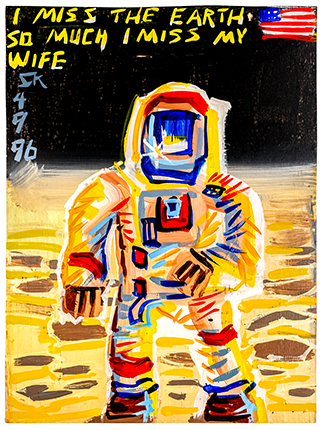
Mac: That’s a pretty great attitude.
Steve: I mean, it might be a cop out, but it might not be. You know, there’s a ton of good artists, but I’m trying to do something different, I guess.
Mac: Well, the phrases thing reminds me of the Raymond Pettibon paintings, which like a lot of people who are into music, I started seeing his work on record covers — first on Black Flag covers, and on Saccharine Trust’s and other bands’, and then in galleries and museums. But I remember always trying to decipher, What does this mean? And what does this have to do with this drawing of a train, or whatever his image was. And then I finally read an interview with him years later, and it was just — I don’t know if “random” is the right word, but it was very much like, “Oh, I heard this phrase in a movie and I just put it on this drawing.” Like the drawing and the phrase weren’t connected. So then it’s putting it on you to kind of make a connection, or make whatever connection your brain gives it.
Steve: Yeah, and for me, it’s sort of like just kind of a pretend songwriter — you know, I’d see friends with their little notebooks, and they’d write a few words and then 300,000 people buy the CD that he wrote the three little words [for].
Mac: Yeah, that’s pretty funny.
Steve: You can make something that just reverberates forever, just with [a thought].
Mac: Yeah. We have a lot of art in our house, and I used to be kind of opposed to — or just not as drawn to art with words on it, actually, because I felt like it was making the work too predetermined, or something like that. In other words, you could look at an abstract painting forever and never really know, or be able to have so many different thoughts about it. But if it has a word on it, you’re like, Well, I already know what the word “cat” means. I don’t need to think about that anymore. But I’ve really changed my way of thinking about that, because if someone does a painting that does involve text and it’s done the right way, then you can still get a million different feelings or thoughts about it, depending on the day or how you think about those words.
Steve: It’s a poem. It’s a springboard.
Mac: Exactly. When you’re painting a landscape, or even a historical painting of someone famous from history or something, are you working from a photograph or anything?
Steve: Yeah, I go to bookstores, junk bookstores, and get tons of old ripped up books and paint from them. It’s a funny thing. Like, I love looking at the old books, I love using the old books, I love chopping up the old books as sort of raw material. My parents always had tons of books, we have tons of books, the radio station had tons and tons of albums with mysterious covers on them. And I just respond to something that already is there. I guess my favorite my favorite artist is Rauschenberg — I can’t get enough, because it looks so effortless. He just throws some things together, but it’s so mystifying. And I also like it because it’s kind of nostalgic, too. His art is old fashioned — you know, he’s been famous for 70 years, he died 20 years ago, and his art is very ‘60s, ‘50s looking. And the books that I get, the history books, are all National Geographics or American Heritages — just American history that we don’t even really follow anymore. We have so much information, so much of everything, it’s hard to know. We study more world history than American history now.
Mac: It’s funny, because so many of those Rauschenberg collage, screen-printed things look like they have images from books, Life Magazine, or whatever he was drawing from. But as a kid, my first real exposure to him that I knew of was in the ‘80s, because I was a big Talking Heads fan and I went out and got Speaking in Tongues when it first came out, because it had this limited edition cover with the Rauschenberg art, which is so cool.
Steve: Yeah. I had this art show at a college in Fort Myers, and that’s about ten miles away from Captiva Island. And the guy that put on my show knew the people at the Rauschenberg Foundation. There’s no visitors there, i’s an art colony — artists work there, they get stipends and stuff. But we got to go there and go to this little boathouse dock room, and supposedly that’s the room that after David Byrne broke up the Talking Heads — I don’t know if he stayed there, but he did a concert for Rauschenberg in that room.
Mac: Oh, really?
Steve: Yeah. He just ran away and was like, “Oh, I’m going to stay with my friend Rauschenberg because I just dissolved the Talking Heads.”
Mac: Wow. My wife is a chef, and she got to go to the Rauschenberg colony for some sort of conference and said it was really amazing. I would love to go there.
I was interested reading the book — I saw your work first probably at [NYC gallery] Thread Waxing, like a lot of people. There were so many shows there, but we had a couple Merge CMJ shows there and I remember one year, I played in Lambchop along with Georgia [Hubley] and Ira [Kaplan] and James [McNew], and Magnetic Fields played. I have some photos from this show somewhere, it was a really great line up. And that was the first time — I had seen your paintings before, but I had never seen a bunch of them in one place, you know what I mean? And that was really amazing and mind blowing. How many years were you working out of Thread Waxing?
Steve: Gosh, it seems like about five years, from the end of ‘93 to — I think the last time I got to have a show there was ‘99, maybe even 2000. And that was terrific. About three or four times a year, they put on shows there and I’d get to drag my stuff out. It was thrilling. It was great. And it’s the only way I feel comfortable looking at my work — I really wouldn’t want to show you, like, ten of my paintings. I’d want you to see 400.
Mac: See the scale of it.
Steve: Because one picture is fine, but the other ones make kind of a story. It’s like a torn apart storybook that you get to make up your own story when you get to look at it.
Mac: Well, reading in the book about your shows that you’ve had and interactions you’ve had with, what you would call, I guess, more traditional art galleries in New York City, I was surprised to read that Marlborough Gallery, which is a legendary place, and PPOW, which is a really cool gallery — I don’t remember what the quote is exactly, but you’re talking a little bit about the essence of what you do, and the way that you sell your art is disruptive to what the traditional way of selling art is, in a gallery system. I was thinking about when we’ve opened for bigger bands on tour over the years, especially when we were first starting and we’re selling our t-shirts for $10 or whatever, because it cost us $5 to make. And then someone’s saying like, “Well, you can’t sell them for that little because that makes the headliner look bad, because their shirts are $20.”
Steve: Oh, I didn’t know that. Wow.
Mac: And so I’m wondering if you’ve ever had that kind of vibe from the, quote-unquote, “art world.”
Steve: Oh, sure. I mean, I shoot myself in the foot doing this. But I do believe that if the art world people have their minds open, they accept me as a performance, as an event. So it can be kind of thought of in a certain way that won’t then attack or glom on to their thing.
Mac: Their traditional thing.
Steve: Yeah. Because for me, the event is the work of art, and people get to take home a souvenir of it.
Mac: That’s a great way of thinking about it. I hadn’t actually thought of it in that terminology, but that totally makes sense. Speaking of events and souvenirs and things like that, are you going to do any events around the book publication?
Steve: I had a show a few weeks ago in Manhattan, and that was fun. It was just for three nights. I sold, like, 1,000 small pictures of the two for $5.
Mac: Oh, cool.
Steve: It’s kind of moving to me, because I’ve been doing this a long time. We’ve been in New York City 28 years, and people come up to me and it’s like, “Oh, I bought your stuff in ‘93 and I gave it all away, and now I’m trying to buy more.” I like it that it feels like I provide a service. It’s like somewhere in between music and food, what I do.
Mac: “Somewhere between music and food” — that could be the name of your next book. [Laughs.] It’s interesting, because I feel like there’s something very punk about what you do. I was talking about growing up listening to classic rock and things on the radio, and I love those bands and records still, but if you went and saw a band in an arena, you wouldn’t have the same feeling of, Oh, I could do that. Because it was meant to be larger than life, right? Whereas if you go see a band in a little club, that was much more of a leveling thing, where you go like, Oh, that person is like me. I could take one step up on that stage and do that.
Steve: I love art that makes me think, Oh, I could do that. That’s a compliment. This sounds bad, but I love old masters and that’s the best art around — you know, Rembrandt, Caravaggio, everything like that. But [with] contemporary art, I’m really not impressed by virtuosity and great skill and stuff, because sometimes, unless it’s really interesting, it kind of pushes me away. It’s like, Wow, that looks like it took a long time to do it. That looks hard.
Mac: [Laughs.] Yeah.
Steve: To me, it’s like magic when you see something that just sucks you in and you don’t know why it’s sucking you in.
Mac: But you’re not standing there just thinking like, Wow, that seems like that really took a long time to get that exactly like that. I feel like you’re an institution — like you’re saying, people come up to you saying all about your paintings from 30 years ago or whatever. So it’s an interesting thing to be reconciling being anti-institutional and punk in a way, but at a certain point, if you do it long enough, you also become an institution.
Steve: Yeah. People still get annoyed at what I do. People used to say to other people, “Oh, why is he doing that?” And now people are like, “Why is he still doing that?”
Mac: [Laughs.] That’s all you can hope for, to keep annoying people in the same way.
(Photo Credit: left, Daniel Efram)


